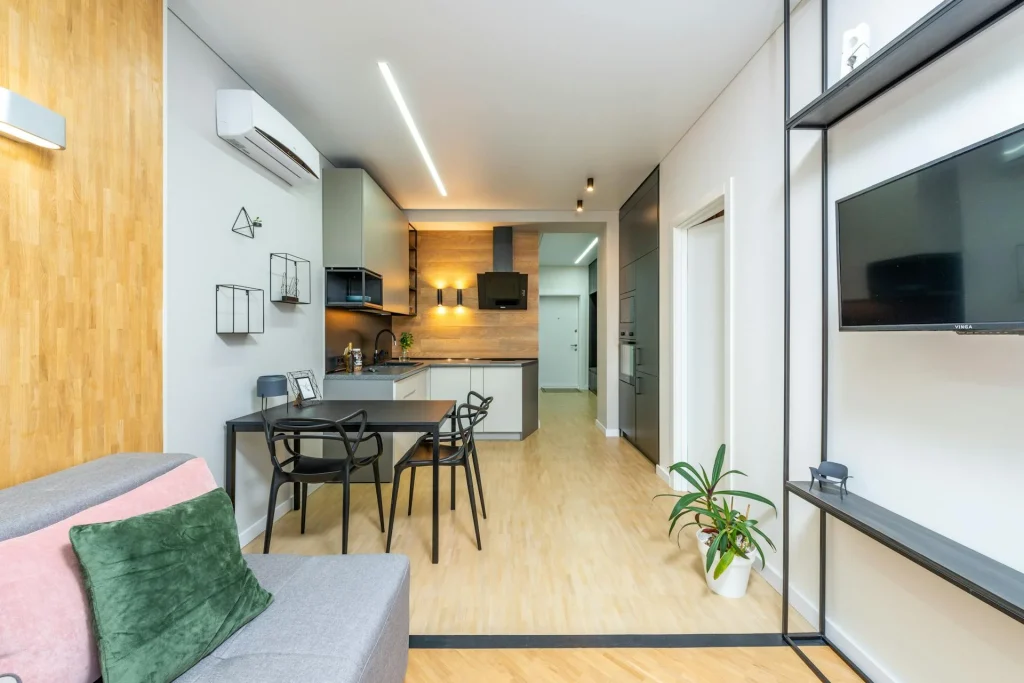Every year, as the mercury rises, property management companies, like Cardinal Point Management, know that homeowners scramble to keep their homes comfortable. Fans come out, blackout curtains go up, temporary window films are stuck on, and portable air conditioners get dragged from the basement—again. But these seasonal hacks often provide little relief. They treat the symptoms, not the root of the problem of Heat Every Summer.
Wouldn’t it be better to remodel once and enjoy a cooler, more efficient home every summer? Instead of throwing time and money at patchwork solutions every year, strategic upgrades can permanently reduce indoor heat and energy bills.
Whether it’s your first remodel or just time for an upgrade, this article is packed with practical and effective remodeling tips to help you stay cool year after year.
Want more on this? Here’s a piece that pairs perfectly.
1. Upgrade Your Air Conditioning System
No matter how well your home is sealed, it won’t feel comfortable without the right air conditioning system. If your current unit struggles to keep up or makes your energy bill skyrocket, it might not be the right fit anymore. Age is another factor. Systems older than 10 years often run less efficiently and may be using outdated refrigerants.
This is the ideal time to call in a licensed technician. They can assess your home’s cooling needs based on square footage, layout, insulation, and climate. You’ll get recommendations for the best AC system for your home —whether that’s central air, ductless mini-splits, or another option tailored to your space.
2. Improve Attic and Roof Insulation
Your attic and roof are often the biggest sources of heat gain in a home. When the sun beats down all day, it heats up your roof, and that heat radiates into the attic and eventually seeps into your living space. If insulation is thin or outdated, it can’t do much to stop it.
Upgrading the insulation in your attic adds a crucial barrier against heat. This helps your cooling system work more efficiently and reduces temperature swings between day and night. Adding ventilation, such as ridge vents or attic fans, can further reduce heat buildup or Heat Every Summer.
3. Install Energy-Efficient Windows
Windows don’t just offer a view—they also let in sunlight and heat. Older, single-pane windows are especially vulnerable to heat transfer. During a remodel, replacing them with energy-efficient alternatives can make a dramatic difference.
Double-pane or triple-pane windows with Low-E coatings reduce solar heat gain while still allowing in natural light. They help maintain a more stable indoor temperature and lower cooling costs.
4. Add or Expand Shading Solutions
One of the simplest ways to block heat before it enters your home is to add shade outside. Sunlight streaming directly into windows and doors raises the indoor temperature quickly. Shading elements like awnings, pergolas, and exterior shutters can help keep spaces cooler.
If you’re also redoing your landscaping, plant trees or shrubs in areas where the sun hits hardest. Vegetation cools the air through natural evaporation and acts as a living barrier that blocks heat and light before they reach your walls and windows.
5. Switch to Cool Roofing Materials
Your roof is one of the largest surfaces exposed to direct sunlight for most of the day. If it’s made from standard dark asphalt shingles or uncoated tiles, it’s likely absorbing and radiating heat straight into your home in Heat Every Summer. The result? Your indoor temperature rises, and your air conditioning system suffers added strain.
Switching to cool roofing materials can significantly lower the amount of heat transferred indoors. These materials are designed to reflect more sunlight and absorb less heat. Options like reflective asphalt shingles, coated metal panels, and even light-colored clay tiles can help. If you’re already planning a roof replacement, choosing a cool roof is a long-term investment in comfort and energy efficiency.
6. Use Light Colors in Your Interiors
Colors can impact temperature more than people often realize. Dark walls, floors, and even furniture tend to absorb and retain heat. In sunlit rooms, this can make a noticeable difference in how warm the space feels throughout the day.
When remodeling, choosing lighter paint tones, flooring, and fabrics helps reflect rather than absorb sunlight. Whites, creams, pastels, and light grays can visually open up a room and make it feel cooler. This doesn’t mean everything has to be white—just aim for softer, brighter hues that reduce heat retention and contribute to a breezier atmosphere overall Heat Every Summer.
7. Upgrade to Smart Home Technology
Smart home upgrades aren’t just trendy—they’re practical when it comes to managing indoor temperature. A programmable or smart thermostat, for example, can automatically adjust the temperature based on your habits. It keeps your home cool when you need it and conserves energy when you don’t.
Other smart additions like motorized blinds, ceiling fans connected to schedules, or room-by-room temperature control systems can help fine-tune your comfort levels. These systems give you better control without the need to manually adjust everything Heat Every Summer.
8. Seal Gaps and Cracks in Walls and Doors
Even small gaps around windows, doors, or wall joints can let hot air in and cool air out. That constant exchange makes it harder to maintain a stable indoor temperature and puts a strain on your AC system.
Remodeling provides the perfect opportunity to seal these hidden leaks. Pay close attention to areas where pipes or wires enter the home, as they’re often overlooked. A well-sealed home won’t just feel cooler—it’ll also be more energy-efficient and less prone to outside pollutants and moisture.
9. Rethink Indoor Lighting and Appliances
Certain lights and appliances generate a surprising amount of heat. Incandescent and halogen bulbs are especially guilty. They convert a large portion of the electricity they use into heat instead of light. In smaller or closed rooms, that can add to the discomfort.
Replacing them with LED bulbs is a simple yet effective step. LEDs use far less energy and stay cool to the touch. When remodeling your kitchen or laundry area, consider installing appliances with better energy ratings. Efficient dishwashers, ovens with better insulation, and properly vented dryers all contribute to keeping your home cooler.
The Coolest Home in Town
Keeping your home cool every summer doesn’t have to mean relying on fans, blackout curtains, or constant AC use. With thoughtful remodeling, you can design your space to resist heat naturally and efficiently. These upgrades work together to enhance the effect. By focusing on lasting solutions instead of short-term patches, you can enjoy cooler days without the stress and costs of seasonal repairs.
Don’t miss our newest articles—they’re all waiting at 2A Magazine.







